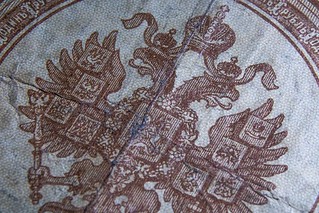
Last week we discussed the 1992 Russian privatization vouchers, and there is some follow-on discussion elsewhere in this issue. A new new book on the paper ruble examines the complete history of the country's currency. Here's an excerpt of a review from the Wall Street Journal.
-Editor
 When reading Ekaterina Pravilova's original, fascinating and meticulously researched
When reading Ekaterina Pravilova's original, fascinating and meticulously researched The Ruble it is a good idea to keep in mind its subtitle: A Political History. For Ms. Pravilova's multi-layered account of the evolution of the paper ruble from its inception in the mid-18th century until the post-revolutionary reforms in the early 1920s goes beyond the merely monetary. The biography of the ruble, explains Ms. Pravilova, is a history of the Russian state, written in the language of money. Regardless of the type of political system in place, she writes, money does not simply reflect an existing (or imagined) social and political order but creates it; it is not a consequence or an attribute but an integral and constitutive part of any regime. Ms. Pravilova, a professor of history at Princeton, shows that the ruble has been, above all, a symbol and an instrument of centralized, autocratic and imperial power.
The story begins in 1769 with the launch, under Catherine the Great, of assignats, Russia's first paper currency. This was, Ms. Pravilova maintains, a risky move. Historically, money had been a token of legitimacy, an indication of the pureness and integrity of monarchical power. But even in Catherine's time, the figurative, if not the literal, flimsiness of paper money posed both economic and political dangers to the absolutist state.
Assignats, which bore a promise of convertibility into coinage, were quick to catch on. They were much easier to carry across a vast empire than coins, and they were fully backed by copper and silver coins lodged in two Assignat Banks. They also came with a temptation—to which, inevitably, the empress succumbed. In the absence of adequate credit mechanisms, it wasn't long before the printing presses sped up to help pay for her wars and the expansion of empire. Russia had shifted to a monetary system in which the state's currency and the state's debt were, to a degree, the same thing. Assignats were backed by an undersized metallic hoard; property pledged by aristocrats; and Catherine's promises. Unsurprisingly, this was not enough to prop up their value.
The article goes on to discuss "sharply divergent views on the future of Russia's money, each wrapped up in sharply divergent views of the Russian state.", following events from the reign of Alexander I (1801-25).
-Editor
 Some relief arrived with the turn to what Ms. Pravilova dubs
Some relief arrived with the turn to what Ms. Pravilova dubs autocratic capitalism in the wake of disaster in the Crimean War. A new, more liberal czar, Alexander II (1855-81), opened the Russian market to foreign traders and investors, adopted free trade and allowed credit rubles to move in and out of the country. This turned rubles into a commodity with its own price, an exchange rate watched keenly by the increasing number of Russians who could travel abroad. Tangible valuables, writes Ms. Pravilova, started yielding their place to intangible resources of every many kinds (securities, bonds, shares), while the role of the ruble became more abstract—the measure of value rather than a value itself.
But the reformers did not go far enough: They spoke the languages of capitalism and autocracy, not seeing the mismatch between the two, Ms. Pravilova notes. It was a preview, in some way, of the internal contradictions that doomed Mikhail Gorbachev's attempts to transform the Soviet system from within.
For more information, or to order, see:
The Ruble
A Political History
(https://global.oup.com/academic/product/the-ruble-9780197663714)
To read the complete article (subscription required), see:
‘The Ruble' Review: Imperial Tender
(https://www.wsj.com/articles/the-ruble-review-imperial-tender-7d83eac3)
To read the earlier E-Sylum article, see:
1992 RUSSIAN PRIVATIZATION VOUCHERS
(https://www.coinbooks.org/v26/esylum_v26n31a31.html)
Wayne Homren, Editor
The Numismatic Bibliomania Society is a non-profit organization
promoting numismatic literature. See our web site at coinbooks.org.
To submit items for publication in The E-Sylum, write to the Editor
at this address: whomren@gmail.com
To subscribe go to: https://my.binhost.com/lists/listinfo/esylum
Copyright © 1998 - 2024 The Numismatic Bibliomania Society (NBS)
All Rights Reserved.
NBS Home Page
Contact the NBS webmaster
|




